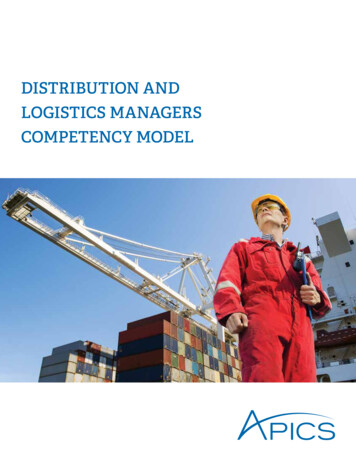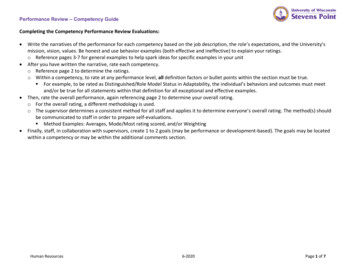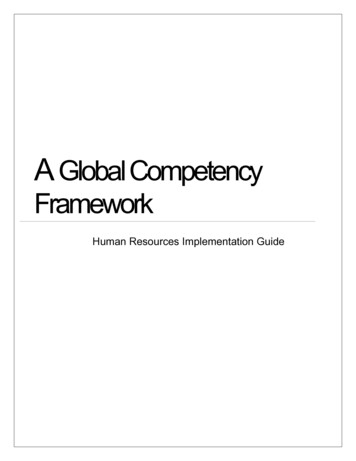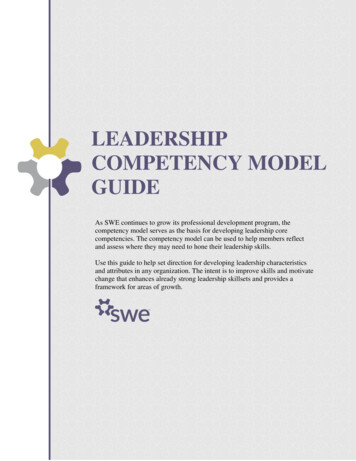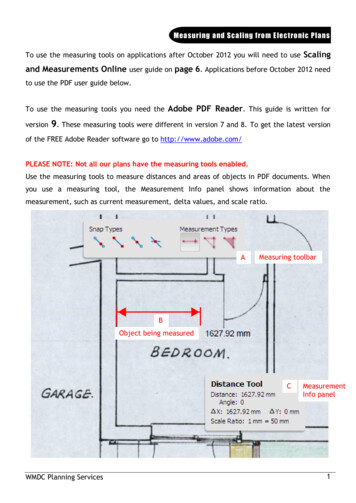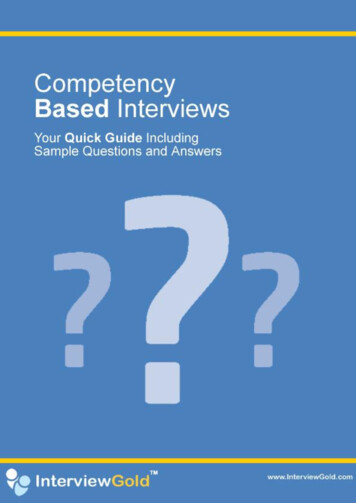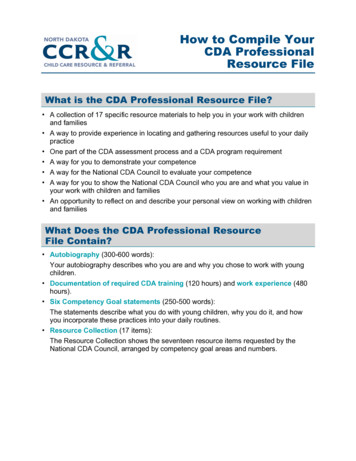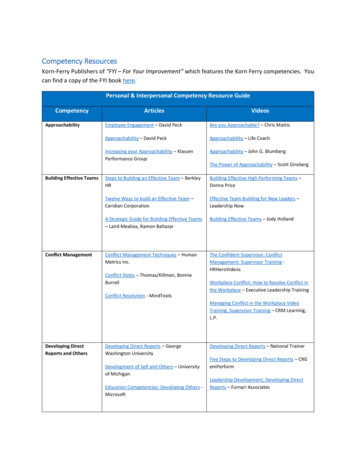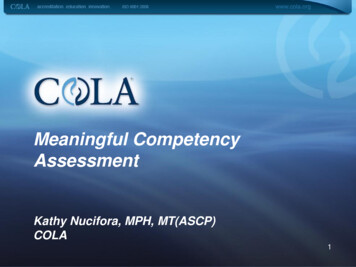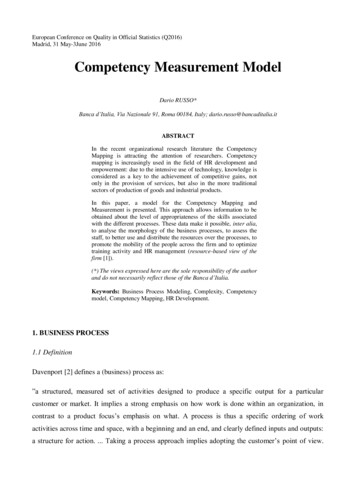
Transcription
European Conference on Quality in Official Statistics (Q2016)Madrid, 31 May-3June 2016Competency Measurement ModelDario RUSSO*Banca d’Italia, Via Nazionale 91, Roma 00184, Italy; dario.russo@bancaditalia.itABSTRACTIn the recent organizational research literature the CompetencyMapping is attracting the attention of researchers. Competencymapping is increasingly used in the field of HR development andempowerment: due to the intensive use of technology, knowledge isconsidered as a key to the achievement of competitive gains, notonly in the provision of services, but also in the more traditionalsectors of production of goods and industrial products.In this paper, a model for the Competency Mapping andMeasurement is presented. This approach allows information to beobtained about the level of appropriateness of the skills associatedwith the different processes. These data make it possible, inter alia,to analyse the morphology of the business processes, to assess thestaff, to better use and distribute the resources over the processes, topromote the mobility of the people across the firm and to optimizetraining activity and HR management (resource-based view of thefirm [1]).(*) The views expressed here are the sole responsibility of the authorand do not necessarily reflect those of the Banca d’Italia.Keywords: Business Process Modeling, Complexity, Competencymodel, Competency Mapping, HR Development.1. BUSINESS PROCESS1.1 DefinitionDavenport [2] defines a (business) process as:”a structured, measured set of activities designed to produce a specific output for a particularcustomer or market. It implies a strong emphasis on how work is done within an organization, incontrast to a product focus’s emphasis on what. A process is thus a specific ordering of workactivities across time and space, with a beginning and an end, and clearly defined inputs and outputs:a structure for action. . Taking a process approach implies adopting the customer’s point of view.
Processes are the structure by which an organization does what is necessary to produce value for itscustomers.”1.2 Building a process modelThe business processes have to be identified, described and measured. A process description impliesidentifying objectives, input, output, constraints, rules, technology, risks. Several techniques areavailable for processes mapping (i.e. Service System Mapping, System Flowcharting, IDEF, ControlFlowchart, SPARKS).The very first stage of the mapping process has to be carried out in a detailed way, in order to catchall the relevant information for process representation and analysis. It is necessary to identify therelated activities and tasks for each process. Process maps must show all the interdependenciesamong processes (i.e. a “process architecture” approach should be followed).1.3 Process inputFor each process the historical series of data on input, output, performance and quality level must berecorded and stored.The overall work time resulting from the relationship between processes and human resources (as apercentage of the FTE on a yearly basis) is the input of each process (see example in Fig.1).PROCESS X RESOURCING - YEAR 2012 ,76%3,54%employee time223245124213222Process x work time33,7237,58124,0097,477,86INPUT300,63Fig. 1Determining the FTE percentage associated to the processes may lead to some accuracy errorsdepending on the frequency of the calculation. The attribution of employee’s time to the pertinentprocesses is made on a different time basis. At least, yearly the team managers determine thedistribution of the team’s FTEs over the processes. Sometimes the allocation of the FTE is made ona monthly basis, rarely a weekly one.2
2. COMPETENCY2.1 DefinitionIn a business environment, characterized by extended structural dimensions and organizationalcomplexity, it is often very difficult to define and identify the competencies of people involved inbusiness processes. Also, it is complex to express these competencies with a common language.Each competency must be associable and linkable to specific processes performed by a company andto individuals, who are the owners of these competencies. Competency management1 has animportant impact on improving the overall quality of the final product, and thus on customersatisfaction.In the literature, several definitions of competency are available. 2 In the HR-XML ConsortiumCompetencies Schema,[9] a competency is defined as:A specific, identifiable, definable, and measurable knowledge, skill, ability and/or other deploymentrelated characteristic (e.g. attitude, behavior, physical ability) which a human resource may possessand which is necessary for, or material to, the performance of an activity within a specific businesscontext.2.2 Development of competency modelsAccording to Draganidis and Mentzas [7] “a competency model is a list of competencies which arederived from observing satisfactory or exceptional employee performance for a specific occupation.The model can provide identification of the competencies employees need to develop in order toimprove performance in their current job or to prepare for other jobs via promotion or transfer. Themodel can also be useful in a skill gap analysis, the comparison between available and neededcompetencies of individuals or organizations. An individual development plan could be developed inorder to eliminate the gap. Important variables to be considered during the development of a1The term competency has became popular with the study of McClelland and his collaborators, especially RichardBoyatzis. In his book “The Competent Manager”, Boyatzis defines a competency as an intrinsic characteristic of anindividual randomly related to an effective or high-level performance (e.g. motivations, skills, own image, knowledge)in executing one or more defined tasks. A broad analysis of the competency management concept can be found inLaura Fortunato, Serena Lettera, Mariangela Lazoi, Angelo Corallo and Giovanni Pietro Guidone, A Methodology forEngineering Competencies Definition in the Aerospace Industry [7].2For a comprehensive review of the different definitions and approaches see Leanne H. Markus, Helena D. CooperThomas and Keith N. Allpress, “Confounded by Competencies? An Evaluation of the Evolution and Use ofCompetency Models” [6] and Fotis Draganidis and Gregoris Mentzas, “Competency based management: a review ofsystems and approaches” [8].3
competency model are the use of skill dictionaries, or the creation of customized ones and thecompetency identification and verification methods – surveys, interviews, focus groups, etc.”Competencies are the building blocks of competency models.Each competency in the model is defined by means of behavioral descriptors. These descriptors canbe defined by determining the highest and lowest levels of proficiency .A simplified taxonomy derived from the huge literature available on this topic 3 groups competenciesinto three categories:a) Knowledge. It concerns everything that can be learned from educational/formative systems andtraining courses and everything which involves cognitive processes (i.e. perception, learning,communication, association and reasoning). It represents the theoretical understanding ofsomething such as a new or updated method or procedure, etc b) Know-how. It is related to personal experiences and working conditions. It is learned by doing, bypractice, by experience. It is the practical knowledge consisting in “how to get something done”.c) Behavior. It is referred to individual characters, talents, human traits, or qualities that drivesomeone to act or react in a certain way under certain circumstances.4Furthermore, an individual has several competencies impacting on organizational activities andpatterns of organizational evolution and change [11]. An activity needs specific competencies to beexecuted and to optimize its performance.KNOWLEDGE (examples)knowledge of IT internal regulationsknowledge of security procedureknowledge of training management procedureknowledge of regulations on business travel and assignmentsknowledge of staff services IT procedure Fig. 234See Bloom’s taxonomy (1954, [10]).Behavioral competencies describe what is required to be successful in an organization outside of a specific job. As such,behavioral competencies are specific to a person rather than to a job. For example, the Team Leader is a person who“effectively manages and guides group efforts; tracks team progress, adequately anticipates roadblocks, and changescourse as needed to achieve team goals; provides appropriate feedback concerning group and individual performance,including areas for improvement” [12].4
KNOW-HOW (examples)know-how of business project managementknow-how of organizational analysisknow-how of English languageknow-how of application development techniquesknow-how of website management techniques Fig. 3BEHAVIOUR (examples)CategoryCompetencyDefinitionBuilding teamspiritProvide team members with theexcitement and desire tocooperate with each other,contributing to common goalsDevelopingpeopleHelp team members to reachtheir potential in onstrated behavior Encourage help andrespect to other teammembers Create a common missionand a feeling ofbelonging to a teamwhich aims at that Provide mentoring andexperience transfer Provide feedback onstrength and weakness ofthe team membersFig. 4Definition of leadership: Effectively manages and guides group efforts; tracks team progress,adequately anticipates roadblocks, and changes course as needed to achieve team goals; providesappropriate feedback concerning group and individual performance, including areas forimprovement [12].The built-up of the model should be made according to the following guidelines.The behavioral competencies could be included according to the general definition provided by theliterature. They don’t depend on the nature of the business but are “embedded” in the resources.Several taxonomies of the behavioral competencies are available and could be adopted.The knowledge competencies are related to the specific business environment. For example, thebusiness processes of an engineering company require technical competencies like the networkingtheory or the programming languages. The choice of the knowledge competencies to be included intothe model is driven by the business sector of the firm.The know-how competencies are strongly connected to the organization of the firm. They arebasically referred to the “rules” (for example, the internal/external regulations) and the procedures(for example, the IT systems).5
2.3 The development and the use of the competency modelTo build up and to use the competency model5 ten sequential steps should be followed.a. to build up the model:1. Create the processes list2. Detect the processes roles3. Create the matrix process/role vs. required competencies with appropriate rating4. Integrate the competencies taxonomy including the owned competencies not included in therequired competencies set5. Create the matrix employees vs. owned competencies6. Create the matrix process/role vs. employees reporting the employees’ effort figures7. Calculate the competency gapsb. to use the model:8. Analyze the data9. Plan the corrective actions10. Repeat the measurement on regularly basis3. COMPETENCY MEASUREMENT3.1 An empiric scaleAccording to the literature6 the 6-level scales are adopted to assess both the Requested and theOwned Competencies.Eq. (2)whereC Competency level3.2 The Process Requested CompetencyThe Required Competency proficiency levels describe the level of a competency required to performa specific process successfully; these levels relate to the work required for the process. Different56The model is usually referred to a solar year.See [4], [10], [11], [13], [12], [14].6
processes require different levels of proficiency for successful performance. Not all processes willrequire the highest level of proficiency and some may not require certain competencies at all [13].The analysis needs a high degree of accuracy: the requested skills should be detected for every taskof the process. To identify the competencies correctly all the activities of the process must bedescribed with the same level of detail. To obtain a homogeneous and detailed definition of thecompetencies of each activity, consideration should be given to the output of the activity togetherwith method, technology and product required to perform an activity [7].COMPETENCY IDENTIFICATIONFig. 5The following proficiency scale has been adopted to assess the Requested Competencies [12].PROFICIENCY SCALE0 - None; 1 - Limited; 2 - Basic; 3 - Proficient; 4 – Advanced; 5 – ExpertProficiencyLevel1. Limited2. Basic3. ProficientDescription Limited or no use of competency required for the job Competency has been minimally demonstrated May have had limited opportunity to apply the competency May have limited understanding of the competency Basic understanding or knowledge needed for the job Basic understanding and knowledge sufficient enough to handle routine tasks Requires some guidance or supervision when applying the competency Understands and can discuss terminology and concepts related to thecompetency Detailed knowledge, understanding, and application of the competency Abilityto handle non-routine problems and situations Requires minimal guidance or supervision / works independently Consistently demonstrates success in the competency Capable of assisting others in the application of the competency7
4. Advanced5. Expert Highly developed knowledge, understanding, and application of the competencyrequired to be successful in the job and organization (total mastery) Can apply knowledge outside the scope of one’s position Is able to coach or teach others on the competency Has a long-term perspective Helps develop materials and resources in the competency Specialist/Authority level knowledge, understanding, and application of thecompetency required to be successful in the job. Recognized by others as an expert in the competency and is sought out by othersthroughout the organization (expert in the area) Works across team, department, and organizational functions Applies skill across multiple projects or functions Able to explain issues in relation to broader organizational issues Creates new applications or processes Has a strategic focusFig. 6The Process-Requested Competency Set Cr is defined as “the set of the rates of all the competenciesrequested by a process”Eq. (4)where:k number of competencies requested by the processexample:competencies/processCompetency 1Competency 2Competency 3Competency 4Competency 5Competency 6Competency 7PROCESS REQUESTED COMPETENCY SETProcess x335Fig. 74544The set of Process Competencies Requested may change over time, when some factors vary: thetechnology, the degree of automation, the external context, the relations with other processes, theregulations, etc.8
The determination of the Process Requested Competencies Set is affected by some arbitrariness, as aconsolidated methodology to determine which level of competency is “the ideal one” for an effectiveperformance of a process is not available. The error introduced by a subjective assessment issignificantly reduced if the difference from a year to another is analysed.Furthermore, the model takes into account the role played by the resources in the process.PROCESSES AND MPLOYEEFig. 8example:Competency 3Competency 4Competency 5Competency 6Competency 7Process x/ role 1Process x/ role 2 Process x/ role nCompetency 2competencies/processCompetency 1PROCESS/ROLE REQUESTED COMPETENCY SET33325344554443314Fig. 93400For example, in the project management, junior staff usually prepares the project papers and theirboss checks the content, the data and the proposals, then he/she makes remarks before the approval.All of them work in the same process, but since they have different roles, the level (and sometimesthe type) of requested competencies are different for the different roles (e.g. a higher “knowledge ofmeetings management” is required for a coordination role). In this paper the “process requestedcompetency” is used instead of “process/role requested competency” to improve its readability.9
3.3 Owned CompetencyWith regards to Owned Competencies, the use of a graduated scale facilitates the identification of thedegree of skill or mastery. Adaptation or combination of commonly used scales such as BloomsTaxonomy7 and the Bondy rating scale 8 is frequent. A scale seeks to summarize the differences in theuse of time, space, equipment and expenditure of energy across the development continuum.The 5-level scale defined in the §3.2 is adopted to assess the Owned Competencies.0 - None; 1 - Limited; 2 - Basic; 3 - Proficient; 4 – Advanced; 5 - ExpertThe competency assessment process is based on the proficiency level description (see fig. 6). Thefollowing scale is used to rate the level of achievement as it occurs in the workplace, classroom ordaily life [24].0 - None: You are aware of information, ideas and situations related to this competency but have notyet had an opportunity to practice it.1 - Limited: You’ve just started to find opportunities to work on this competency. You make initialassessments of what is expected of your role. Your understanding of the impact of your actions islimited. Your actions meet some performance expectations but you know that you could improve.2 - Basic: You’ve demonstrated this competency and think about how to develop it further. Youengage in conversations with others about how you can best contribute and how this competency isimportant.3 – Proficient: Your actions usually meet the expectations of yourself and others. You look foropportunities to apply this competency in other areas of your life.4 - Advanced: You’ve reached your overall goals and often think about opportunities to use andpractice this competency. You consistently meet the expectations of yourself and others. You consideryour learning and appreciate the significance of this competency in relationship to your experiences.You demonstrate high quality work that has a positive impact.7“Bloom’s taxonomy of educational objectives” [14] is a system for categorizing educational objectives according to ahierarchy of behaviors. The concept of taxonomy refers to the nature of the knowledge, skills and attitudes to belearned, in ranked order, with simple behaviors listed first and more complex behaviors listed thereafter.8Kathleen Bondy [15] captures the essence of Bloom’s affective and psychomotor domains by applying the concept of ahierarchy of increasing competency to the development of a five-point rating scale for the evaluation of nursingstudents’ clinical performance. Bondy’s rating system was developed to be applied to any professional behavior and isintended to evaluate the amount of supervision required to carry out professional responsibilities.10
5 - Expert: You have an overall mastery of this competency. You understand and demonstrate it in allareas of your life. You are considered to be a role model by others and regularly exceedexpectations. Your work is of a very high or exceptional quality and has significant impact.A specific scale is adopted to assess the Leadership.LEADERSHIP PROFICIENCY SCALEUnsatisfactory Performerlevels 1/2Fails to involve his/her team indefining goals and planning theways to achieve team successSets goals for the team but doesnot adequately communicatethose goals to get everyone “onboard”Does not maintain anunderstanding of where the teamis toward reaching its goals;therefore, is unable to provideupdates to other stakeholders(e.g., customers, peers,supervisor) when askedInconsistently provides feedbackto team members; avoidspresenting feedback that will notbe well-receivedSuccessful Performerlevel 3Involves team members indefining ways to achievedesired results and definingexpectations about how teammembers will work togetherSets and communicates cleargoals for the team up frontExceptional Performerlevels 4/5Encourages a sense of mutualaccountability in team settingsthat motivates individuals todo his/her best for each otherand exceed goalsIdentifies the most importantpriorities for the team andfocuses attention effectivelyMonitors team performancecontinuously and provides“real time” project updates tostakeholders (e.g., customers,peers, supervisor) on a regularbasis and/or when askedProvides direction to lessexperienced team leaders onhow to monitor the teamwithout interfering withprogressProvides meaningful feedbackto team members to keep themon track toward common goalsDemonstrates an ability toidentify underlyingperformance issues amongteam members and deliverhighly insightful feedbackEffectively gives constructivefeedback even when themessage is extremely difficultto deliverProvides unbalanced feedback toteam members; may presentmessages that are overly harsh orcriticalProvides feedback regardingboth strengths anddevelopment needs on aregular basis; ppropriatelybalances positive and negativemessagesAnticipates only the mostUses past experience toobvious potential problemsanticipate possible problemsand/or fails to help teamand coach team members onmembers overcome roadblocks as how to successfully navigatethey occuraround themFig. 10Helps team members developtheir ability to anticipateproblems by leveraging theirpast experiences so that theycan work more independently3.4 Competency assessmentThe competency assessment is the process of comparing an individual’s competencies to those of acompetency model.11
Assessments are systematic methods of gathering data under standardized conditions and reaching aconclusion regarding the knowledge, qualification and potential of an employee [25].Competency assessment is an ongoing process of continually building knowledge and skills.Organizations are much more dynamic now and competency assessment addresses the need to stayahead of the curve.“In business environments, characterized by extended structural dimensions and by organizationalcomplexity, often it is very difficult to objectively define and identify competencies of people involvedin business activities. Also, it is complex to express these competencies with a common languageshared by all the companies belonging to the network” [7].There is a number of different ways of performing competency assessment [22] [23].The first is the so-called “self-assessment”. Following this methodology, people assess themselvesagainst a pre-determined set of competencies, and using a pre-determined evaluation scale. Often, inthe self-assessment methodology the employee is also requested to define a certain number of “areasof strength” and of “areas of weakness“.Usually this methodology is used by the company in combination with another one (manager’sevaluation and/or structured test and/or assessment center and/or manager’s assessment). Themanager of the organisational unit (office, division, and department) assesses all the employees andevaluates their level of competency. The evaluation refers only to the competencies required by theorganisational position of the employee and a pre-determined evaluation scale is used. Generallyspeaking, this methodology is used where the number of employees is not too high and thus it ispossible for a manager to have detailed knowledge of the competencies levels of each staff member.This approach has been adopted in the experiment.Another way to assess the competency is the structured test. This methodology usually refers toassessing recall of facts, concepts, principles, and basic application in a standard examination format.There are three common exam formats: multiple choice questions (MCQs), essay questions, andshort-answer questions. Unfortunately such tests are available only for few competencies.The assessment center methodology is used to evaluate behavioral competences. An assessmentcenter is a series of assessment tests carried out using several techniques like simulation,psychometric test and exercises to take critical decisions like selective or rejecting a candidate forrecruitment, promotions, etc.12
In order to limit the risks of inaccuracy stemming from the “bias” of the manager/assessor, theproficiency scale described above is integrated by a detailed evaluation scale (see Annex 1). Thisscale contains more circumstantial definitions. For each competency category (knowledge, knowhow, behaviour) a customised definition of each level of the scale is provided.At the end of the performance year each employee is rated on his/her performance against therelevant competencies.The set of Owned Competencies Co encompasses all the competencies owned by the employeeEq. (3)where:m number of competencies ownedexampleA. Smith535415ipleadershency 6Competency 5Competency 4Competency 3Competency 2Compet/employeeency 1competenciesCompetOWNED COMPETENCY SET4Fig. 113.5 Foreign languages competencyThe Common European Framework of Reference for Languages: Learning, Teaching, Assessment,abbreviated as CEFR, is a guideline used to describe achievements of learners of foreign languagesacross Europe and, increasingly, in other countries 9. It is adopted in the model. The CommonEuropean Framework divides learners into three broad divisions that can be divided into six levels:A - Basic UserA1 Breakthrough or beginnerA2 Waystage or elementary9It was put together by the Council of Europe as the main part of the project "Language Learning for EuropeanCitizenship" between 1989 and 1996 Its main aim is to provide a method of learning, teaching and assessing whichapplies to all languages in Europe. In November 2001 a European Union Council Resolution recommended using theCEFR to set up systems of validation of language ability. The six reference levels are becoming widely accepted as theEuropean standard for grading an individual's language proficiency.13
B - Independent UserB1 Threshold or intermediateB2 Vantage or upper intermediateC - Proficient UserC1 Effective Operational Proficiency or advancedC2 Mastery or proficiencyThe CEFR describes what a learner is supposed to be able to do in reading, listening, speaking andwriting at each level [19].The following table shows the correspondence between the CEFR levels and the 5-level scale.CEFR LEVELS AND THE 5-LEVEL SCALE.CEFRA1A2B1B2C1C25-level scale112345Fig. 124. COMPETENCY GAP4.1 Competency GapThe Competency Gap is the difference between the Requested Competencies and the OwnedCompetenciesEq. (5)where:Particular cases:Eq. (6)G 0 no GapEq. (7)G 0 owned competencies greater than requested competencies G 0Example 114
OWNED COMPETENCY LESS THAN REQUESTED COMPETENCYResource: A.W. Smith – Process: xcompetencyProcess xrequested- owned54G - Gap1Fig. 13Example 2OWNED COMPETENCY GREATER THAN REQUESTED COMPETENCYResource: A.W. Smith - Process: xcompetencyProcess xrequested- owned35G - Gap0Fig. 144.2 Gap calculation4.2.1 Competency vs. Process Gap [Gr/p]The Competencies vs. Process Gap is defined as “the arithmetic mean of the gaps between a person’sOwned Competencies and the Requested Competencies of the process”.Eq. (8)where:n number of Requested CompetenciesGc(i) gap between the ith-Requested Competence and the ith-Owned CompetenceEq. (9)Consequently:Eq. (10)15
A person shows a specific Competency Gap for each process which is involved. As stated before10,the positive gap must be put equal to 0.4.2.2 Process Competence Gap [Gc]The Process Competence Gap is defined as “the weighted average of the Competence vs. ProcessGap of all the resources involved in the process”. The weight depends on the work time of eachperson (on a yearly basis).Eq. (11)where:Gr competence gap of each resource involved in the process.t time worked by each resource in a year.4.2.3 Process Leadership Gap [Gl]The Process Leadership Gap is defined as “the difference between 5 and the Managerial Skills(Leadership) rate owned by the Process Leader11”.Eq. (9)where:L is the Managerial Skills (Leadership) rate of the Process Leader.Eq. (10)consequently:Eq. (11)4.2.4 Process Gap [Gp]The Process Gap is defined as “the arithmetic mean of the Process Competence Gap and the ProcessLeadership Gap”.1011See §4.1, Eq. (7).The process leader is the manager or the professional who has the responsibility of the process management.16
Eq. (12)where:Eq. (13)As consequence of the usage of the arithmetic mean in the gap calculation, the same relevance isattributed to all the competencies.PROBABILITY OF COMPETENCY GAPreq. level /owned level0123450120123450012340001233000012Fig. 1545probability of gap0000010000000/61/62/63/64/65/6In reality, due to the absence of “positive gap”, the higher the relevance of a competence in a processis, the bigger the probability of having a gap. Apparently the introduction of an additional rate toweight the gaps could increase the accuracy of the model, but it complicates it, in particular for themaintenance. Moreover, as the rating process is totally empiric, the addition of another empiricfigure could not reduce the inaccuracy significantly.Competency 752Fig. 16Competency 632Competency 531Competency 4Competency 2req. levelgap weightCompetency 3competencies/process: xCompetency 1PROCESS WEIGHTED REQUESTED COMPETENCY SET415342425. USING THE MODEL5.1 Analysis of the competency mapThe competency map could be used to perform some process analysis based on the requestedcompetencies and some staff analysis based on the owned competencies.17
a. Process requested competenciesThe following table depicts a sample process/role requested competency set.PROCESS/ROLE REQUESTED COMPETENCY SETprocess/ competenciesCompetence 1Competence 2
Keywords: Business Process Modeling, Complexity, Competency model, Competency Mapping, HR Development. 1. BUSINESS PROCESS 1.1 Definition Davenport [2] defines a (business) process as: ”a structured, measured set of activities designed to produ
